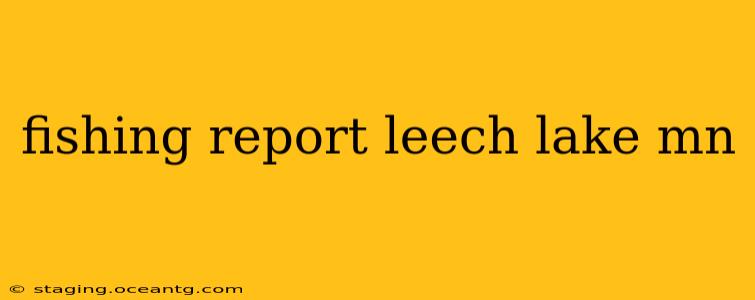Leech Lake, a sprawling 385-square-mile lake nestled in the heart of Minnesota, is a renowned fishing destination. Known for its abundant walleye, muskie, and northern pike populations, it attracts anglers from across the country. This report provides an up-to-date overview of the fishing conditions, offering insights to help you plan your next Leech Lake adventure. While specific conditions change daily, this guide will provide a strong foundation for your trip planning. Remember to always check local fishing regulations and obtain the necessary licenses before heading out.
What are the best fishing spots on Leech Lake?
Leech Lake's vast size offers diverse fishing opportunities. Popular spots include:
- Walker Bay: Known for its excellent walleye fishing, particularly during the spring and fall. Shallow reefs and points here provide ideal habitat.
- Big Sandy Lake: A large, connected basin teeming with both walleye and northern pike. Look for weed beds and drop-offs.
- Boy River: This river system feeds into Leech Lake and is a great spot for targeting muskie and northern pike. Focus on areas with current breaks and structure.
- Cut Foot Sioux Bay: This area is known for producing consistent catches of walleye, particularly during the summer months.
Remember that the "best" spot depends on the species you are targeting and the time of year. Consulting with local bait shops and guides can provide invaluable real-time information on the most productive locations.
What kind of fish are biting on Leech Lake right now?
The current bite on Leech Lake is dynamic and depends greatly on the season. Generally, expect to find:
- Walleye: A year-round target, though the best times are spring and fall. Different depths and techniques will be most effective at different times of year.
- Muskie: A challenging but rewarding fish to catch. Summer months often see increased muskie activity.
- Northern Pike: Abundant throughout the lake, particularly in shallower weed beds.
- Largemouth Bass: Found in shallower, weedy areas.
- Smallmouth Bass: More common in rocky areas and deeper structures.
- Panfish: Sunfish, crappies, and perch are common and offer excellent fishing for families.
What are the current water conditions on Leech Lake?
Water levels and clarity fluctuate throughout the year. Checking current reports from local sources, such as bait shops or online fishing forums, is vital for staying up-to-date. Factors to consider include water temperature, clarity, and recent rainfall. This information directly impacts fish behavior and the best techniques to employ.
What is the best time of year to fish Leech Lake?
Leech Lake offers excellent fishing throughout the year, but each season presents unique opportunities:
- Spring: Walleye spawn, resulting in excellent fishing opportunities.
- Summer: Muskie and Northern Pike become more active.
- Fall: Walleye fishing remains strong, and fall colors provide stunning scenery.
- Winter: Ice fishing is popular for targeting walleye, northern pike, and other species.
What techniques are working best on Leech Lake right now?
The most effective fishing techniques vary depending on the target species and time of year. However, some common approaches include:
- Trolling: Effective for walleye and muskie.
- Jigging: A versatile technique for various species, particularly walleye and panfish.
- Casting: Ideal for targeting northern pike and bass in shallower areas.
- Live Bait: Effective for attracting a range of species.
What are the fishing regulations for Leech Lake?
Always check the Minnesota Department of Natural Resources (DNR) website for the most up-to-date fishing regulations before your trip. Regulations cover things like daily limits, size restrictions, and required licenses. Understanding and complying with these regulations is essential for responsible fishing.
This report is meant to give you a good overview. Conditions change frequently, so always consult local experts for the most current and precise fishing information. Tight lines!
